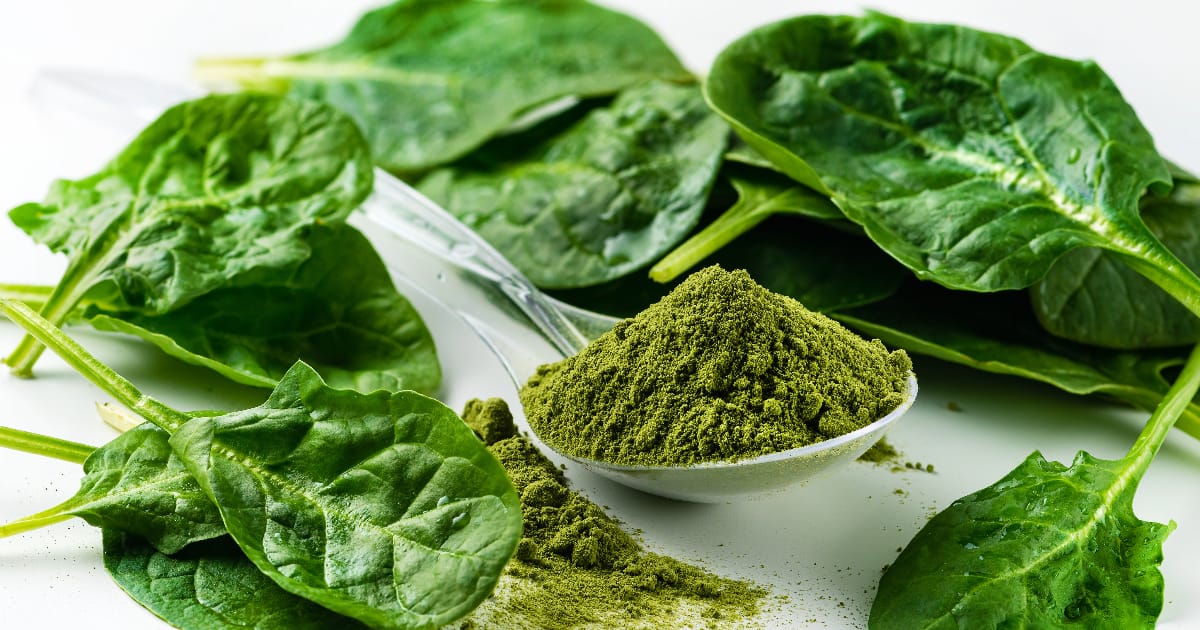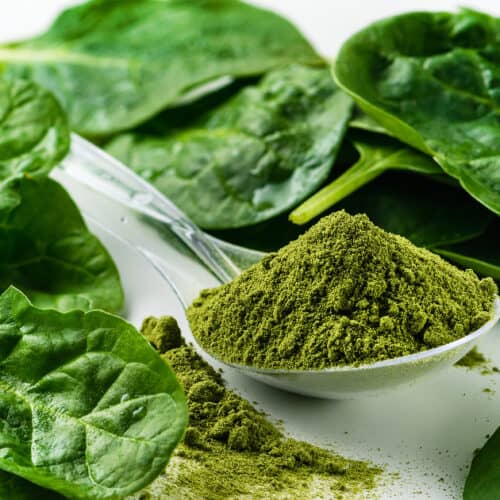Spinach is one of the healthiest leafy green vegetables you can eat. It is packed with vitamins, minerals, and antioxidants that provide many health benefits. By dehydrating fresh spinach leaves and grinding them into a powder, you preserve most of the nutrients while extending its shelf life so none goes to waste.

Spinach powder is very versatile. You can sneak extra nutrition into meals by adding it to smoothies, baked goods, soups, casseroles, pasta sauces, dressings, dips, and more. Your family may not even detect the added vegetable!
Step by Step Instructions:

Spinach Powder Recipe
Ingredients
- Spinach Leaves
Instructions
Harvest or Purchase Spinach Leaves
- You can use fresh spinach from your garden or spinach bought at the grocery store. Organic is best if possible to avoid pesticides.
- When working with bulk spinach, give it a good rinse under cold water first. Pay extra attention to cleaning organic spinach as it may contain more dirt if not washed before packaging.
Dry Spinach Leaves Thoroughly
- Before dehydrating spinach, you want to remove as much moisture as possible from the surface of the leaves. Having wet spinach going into the dehydrator will slow down the process.
- After rinsing off the spinach, use a salad spinner to remove excess water. You can also let leaves air dry for 10-15 minutes on a towel before loading your dehydrator trays. Removing surface moisture will cut down total dehydrating time.
Dehydrate Spinach Leaves
- Now you're ready to dehydrate those spinach leaves! This step removes all remaining moisture slowly and thoroughly.
- For an electric dehydrator, set temperature between 125-135°F. Arrange leaves in a single layer on trays. Rotation of trays and checking spinach every 2 hours ensures even drying.
- Total dehydration time will be 4 to 8 hours. Leaves should be brittle when completely dry. Stems may take a bit longer than leaves to fully dehydrate.
- You can also use an oven set to the lowest temperature, around 170°F. For ovens that don't go that low, prop the door open slightly.
Allow Dehydrated Spinach to Cool
- Once spinach leaves are crispy and crumbled easily when squeezed, turn off your dehydrator or oven. Allow leaves to come down to room temperature before the next step.
- Transfer dried leaves into a bowl or onto a baking sheet while cooling. Break leaves down into smaller pieces by crumbling between your hands over the container.
Make Spinach Powder
- To grind leaves into a fine powder, you can use a dedicated coffee grinder, blender, food processor, or even mortar and pestle. Add leaves a handful at a time and grind into a powder consistency you desire.
- A good blender or food processor works fastest to powder your dried spinach. Coffee grinders are great for small batches. Blend in short 5-10 second bursts to prevent overheating spinach.
- You now have homemade spinach powder ready for adding to all kinds of recipes!
Key Takeaway: Grind dried spinach leaves into powder using a blender, food processor or coffee grinder. Work in small batches for best control of texture.
| Equipment | Time to Powder | Batch Size |
|---|---|---|
| Coffee Grinder | 1-2 minutes | 1/4 cup |
| Small Blender | 30 seconds - 1 minute | 1/2 cup |
| Food Processor | 30 seconds - 1 minute | 1+ cups |
Storage Tips
Proper storage keeps your homemade spinach powder fresh for 6 months up to a year. Follow these tips:
- Allow powder to come to room temperature before packing into containers
- Use very clean, airtight glass jars or plastic containers
- Store containers in a cool, dark place like a pantry
- Check periodically for moisture buildup
If you ever detect moisture droplets inside the jar, place powder into dehydrator for more drying time.
How to Use Spinach Powder
Now that you have made your own spinach powder, it's time to start adding it to foods! Here are some tasty ways to use spinach powder:
Smoothies: Add 1-2 teaspoons per serving. Spinach powder boosts nutrition without affecting flavor.
Baked Goods: Add up to 1/4 cup of spinach powder per recipe to muffins, breads, pancakes and more.
Pasta Sauce: Mix in 1-3 tablespoons per batch. Adds nutrition and also colors sauce green!
Casseroles or Stews: Sprinkle 2 tablespoons per dish. Adds vitamins while cooking but doesn't alter taste.
Eggs: Add 1 teaspoon per cup of eggs when making scrambled eggs or omelettes.
Dips: Stir in 1-2 tablespoons of spinach powder into spinach artichoke dip, ranch dressing, etc.
As you can see, the options are endless for adding spinach powder into meals and snacks! Try working it into your family's normal recipes to increase daily vegetable consumption.
FAQs
Should spinach be blanched before dehydrating?
Blanching is not necessary as it does not affect safety or nutrition of the dried spinach. Many people consume raw spinach frequently. The dehydration temperatures also eliminate any compounds of concern in unblanched leaves.
Can I use frozen spinach instead?
Yes, you can dehydrate frozen spinach leaves once thawed and patted dry. Follow same dehydrating directions as for fresh spinach.
How long does homemade spinach powder last?
Properly dehydrated spinach powder keeps 6-12 months stored in an airtight container in a cool, dark place. Check periodically for moisture buildup.
What is the nutrition difference vs. fresh spinach?
Dehydrating spinach retains most of the original vitamin and mineral content. You get nearly the same nutrition boosting power as you would from fresh spinach per serving, concentrated into powder form.
Conclusion
As you learned, making your own spinach powder only takes a few simple steps. Now that you have a batch of spinach powder, mix it into smoothies, baked goods, soups, sauces and more! Adding this versatile powder allows you to consume more vegetables for better health.
The spinach powder recipe also helps reduce food waste. You preserve fresh spinach harvested from your garden or use up that spinach going bad in the fridge! Making powder extends the shelf life of leaves up to a year.

